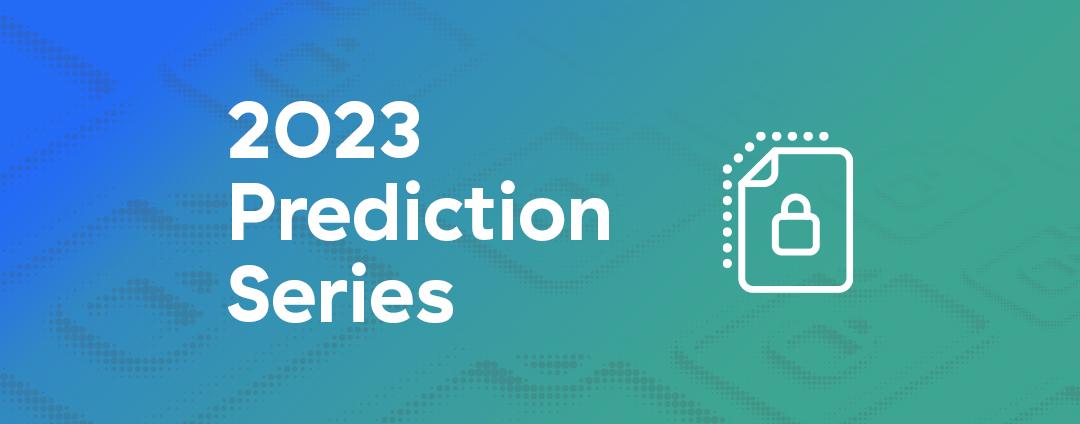It’s that time of the year – predictions! With the close of every year, it makes sense to take stock of where we’ve been and where the industry may be headed. When we think about some of the most important issues facing the cybersecurity industry in 2022, I can’t think of anything more important than data protection. When most think about data protection, technologies such as encryption and data loss prevention come to mind, however, data protection has always been intrinsically tied to effective cybersecurity. It’s what’s at the heart of every organization, and what all those defenses are protecting.
So, with that, let's break out our crystal ball and make five bold predictions that will put data protection on center stage for 2023:
On-premises data protection will say its farewell
While this is a pretty bold statement, it’s clear that every organization is currently evaluating its on-premises approach to data protection. Digital transformation has accelerated cloud adoption and has created distributed data across SaaS, IaaS and PaaS, and employees are accessing this data remotely, off network. Legacy data protection technologies just can’t protect cloud data nor can they scale in this new world of cloud and mobility. The majority of data is now being created and shared in cloud services, applications, and workloads bypassing traditional on-prem data protection solutions. While organizations with heavy SOC operations may take time to make the shift to cloud data protection, the writing is clearly on the wall, and 2023 is when it will reach a tipping point.
Where in the cloud are customers headed? As organizations move toward zero trust and migrate away from rusty hardware and cumbersome software, they are adopting Security Service Edge (SSE) as the path forward. Coined by Gartner last year, this consolidation of data protection, SWG, and ZTNA is the most logical destination for tomorrow’s data protection strategies. Through consolidation of services delivered from the cloud, organizations can break free from the restrictions bound by their legacy architecture and finally deliver always-on protection for every user, device, and location from a high-performance platform that enables full SSL inspection and visibility across all traffic.
Data protection programs will cross the chasm and start to succeed
Most CISOs that have been around for a while probably have a story in their past or present about a failed data protection program. It’s common to hear that either the program failed due to costly or complex daily operations, or challenging user environments. The prediction is that this is all about to change, because consolidation through SSE has major underlying operational and program benefits. First off, centralized policies drastically simplify things. The ability to turn on data protection as a service across all cloud services, web traffic, SaaS applications, and workloads (S3 Buckets), including endpoint, is a game changer.
In contrast, legacy data protection focused on hardware and data center solutions can take organizations up to two years to fully implement. Additionally, modern SSE solutions are now drastically streamlining daily operations with ML approaches that help reduce deployment times by months, which leads us to our next prediction
Machine learning and big data will usher in a new age of data visibility
The days of having your data protection dependent on a skilled staff of analysts are changing. Sure, some overall operations staff will be required, but things are about to get much easier. AI and ML are some of the most powerful technologies currently at the industry's disposal, and they hold the potential to transform how data protection is done. For example zero configuration data protection now helps organizations deploy complete data protection in a fraction of the time as normal program methods. Instead of spending months coordinating with business owners on what data should be blocked, or struggling to build the proper DLP dictionaries to find the right data, you can fast forward to the good stuff - blocking data. With zero configuration data protection, ML-powered inspection automatically highlights every single piece of sensitive data in your network, and categorizes it in easy-to-manage buckets that enable quick exploration and policy blocking - all in minutes, without lifting a finger. This is a complete game changer for data visibility.
Another big benefit of cloud-based platforms is around the concept of big data. Big data creates an opportunity for analytics and behavioral analysis, providing customers with unprecedented insights. Because cloud platforms are seeing everything, across all users, devices, and locations, they get an uninterrupted view into all behaviors - good, bad, and ugly. In the security industry it’s always the bad and the ugly that are the most interesting, and with user and entity behavior analytics (UEBA) and big data, this can really help drive down risk. From impossible travel to suspicious bulk uploads, UEBA is an important part of a good data protection program that is only going to get better and better as consolidation, big data, and machine learning converge. While these benefits don't always trickle up to the CIOs and CFOs, the CISO organization sees it immediately.
Data is central to zero trust and security operations
Many organizations struggle with the concept of zero trust, partly due to industry using the term to describe everything under the sun. But it’s important to understand that zero trust is an outcome of the proper architecture. To frame this, it’s important to think of SSE as a user to destination discussion. Get the right user to the right destination, without dependence on a trusted network. Use identity to confirm it’s the right user, and build it in a way that the network is irrelevant. That’s it - regardless if you're talking SWG, CASB or ZTNA - it’s always user to destination focused. So how does data protection fit into all of this? It's simple, really. Data is at the heart of everything. To this end, it’s important to ensure that your data protection and DLP approach is built on a strong foundation of zero trust.
Data is also a critical component of modern detection and response solutions such as extended detection and response. Visibility into data adds critical context to threat hunting that can uncover possible attacks early in the MITRE ATT&CK. As data is the goal for most bad actors, having insights of data pervasive across all threat vectors, email, endpoint, cloud apps, workloads, and web adds important context to threat hunting.
Adaptive data protection will save lives and jobs
As mentioned in prediction 3 above, the adoption of more powerful analytics will be a huge asset to companies. This reality then sets up our last prediction. When platforms can intelligently detect trends and analyze behavioral patterns, we can then use this visibility to automagically adapt policies based on risk. Imagine how simple life would get if you could throttle down a user's access level if you knew that suspicious activity like impossible travel was happening. Without any human intervention, your data protection platform is now working with you to react to incoming risk, and potentially helping thwart a breach. This faster-than-human, quick reaction will help countless organizations and CISOs fight incoming threats better than ever before. While user behavior analysis is not new in security operation centers or integration with cloud access security brokers, it is rarely implemented in a true end-to-end SSE environment.
Putting it all together
Hopefully you’re starting to see a theme. While zero trust and SSE won’t solve all your problems, the advantages of consolidating data protection are quite eye-popping. When data protection is delivered from—and integrated into—the right cloud platform, that is built on the right zero trust architecture, organizations can get one step closer to where everyone wants to go - zero trust data protection.
Interested to learn more about how to protect your data in 2023? Click here for Zscaler’s perspectives.
This blog is part of a series of blogs that look ahead to what 2023 will bring for key areas that organizations like yours will face. The next blog in this series covers digital experience monitoring predictions for 2023.






